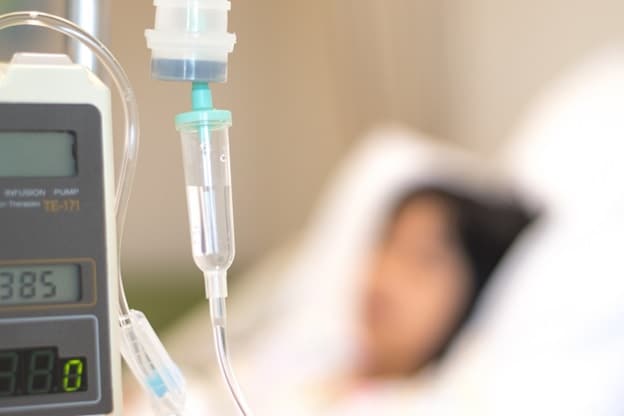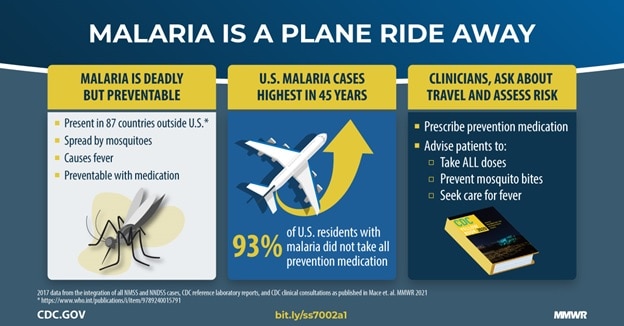World Malaria Day 2021
In late 2020, an otherwise healthy woman in her 40s returned home to Tennessee after a mission trip to a sub-Saharan African country. Following three days of fever, chills, sweats, and headache, she went to a local emergency room and was tested for COVID-19 and malaria. Her condition rapidly worsened.
When her blood test came back positive for malaria six days later, her doctors contacted CDC’s expert 24-hour malaria hotline for guidance on treatment. After that call, her care team arranged for her to be air-lifted to another facility where she could start an urgent course of antimalarial medicines. Sadly, it was too late; she died a few days later.
Each year on April 25, CDC joins the global community to recognize World Malaria Day because malaria remains a leading cause of preventable illness and death around the world. Malaria was eliminated from the United States 70 years ago yet still infects 2,000 Americans each year.
CDC has a decades-long history fighting malaria. In fact, eliminating malaria was CDC’s founding purpose when it started in 1942 as the agency for Malaria Control in War Areas, designed to keep the southeastern states malaria-free during World War II. By the early 1950s, malaria was eliminated from the United States.
The devastating case of the woman from Tennessee is a reminder that our work is not done. Crucially, drawing the line against malaria also requires holding the line in the United States to sustain progress.

The number of malaria cases diagnosed domestically has been increasing since the mid-1970s corresponding to the increase in international travel, particularly to places with malaria. A new CDC publication shows that malaria cases in the United States rose to 2,161 in 2017, the highest number in 45 years. This is an unacceptably high number for a preventable and treatable disease.
For the last two years, in the absence of a commercially-available, FDA-approved antimalarial drug, CDC has delivered lifesaving injectable artesunate—the first line drug and global standard for treatment of severe malaria—to patients in need.
In May 2020, FDA approved artesunate for treatment of severe malaria in the United States. The commercial availability of Artesunate for Injection™ launched in March 2021external icon.
It may take some time between the commercial launch of Artesunate for Injection™ and adequate stocking in pharmacies and hospitals across the United States. In the meantime, CDC will continue releasing artesunate in situations where FDA-approved Artesunate for Injection™ is not available within 24 hours of a clinician requesting it. Once availability expands nationwide, CDC will discontinue its distribution.
Treatment is just one aspect of our domestic malaria strategy. We want to prevent travelers from getting malaria in the first place. CDC does this in three ways:
- Educating Americans about the risk of malaria, and offering prevention tips and medication to use when visiting malaria-endemic regions
- Helping healthcare providers diagnose and treat malaria in the United States promptly and correctly
- Working with our partners to reduce the global burden of malaria. Reducing the risk of contracting malaria internationally helps everyone, including American travelers (business and leisure) and servicemembers
Malaria kills more than 400,000 people around the world every year, mostly young children. However, with proven tools and methods such as insecticide-treated bed nets, better case management of malaria in children and pregnant women, expanded use of preventative medicine during high malaria transmission season, and insecticide resistance monitoring, these numbers should come way down.
With the massive scale-up of proven malaria prevention and treatment interventions, more than 7.5 million lives have been saved since 2000.
Over the last few decades, CDC and the global community have made progress in this fight. Fifteen years ago, malaria killed nearly 1.2 million people annually. Today, we have reduced that number by more than half.
CDC is an international leader in malaria research and innovation, providing scientific expertise to countries and partners to improve surveillance, lab systems, mosquito control, and management of cases. Our priorities include:
- Developing and evaluating novel interventions. CDC strives to improve mosquito control and malaria prevention by evaluating novel interventions such as spatial repellentsexternal icon (chemicals that are released into the air and prevent mosquitoes from biting humans within a given space), attractive targeted sugar baitsexternal icon (devices that attract mosquitoes with sugar and then kill them), and the RTS,S malaria vaccineexternal icon which could potentially reduce the incidence of malaria in fully vaccinated children by 40%.
- Monitoring for malaria drug resistance. Monitoring for antimalarial resistance helps explain treatment failure and leads to better recommendations for treatment. As part of the U.S. President’s Malaria Initiative (PMI)-supported Antimalarial Resistance Monitoring in Africa (PARMA) Networkexternal icon, CDC developed a highly sensitive method for assessing malaria drug resistance. Since 2019, CDC has trained investigators from 15 African countries to help them monitor for drug resistance in their home countries.
- Tracking an emerging threat – Anopheles stephensi. In 2012, routine public health tracking activities detected that a mosquito species called An. stephensi had found its way from its native habitat in Southern Asia to Eastern Africa. Initially spotted in Djibouti, it has since been identified in neighboring Ethiopia, Sudan, and Somalia. Unlike many of its cousins, An. stephensi thrives in urban settings. This has made it difficult for countries to control the mosquito population, since it behaves very differently from local African mosquitoes that transmit malaria. CDC and PMI staff are working to learn how and where An. stephensi is spreading and finding effective ways to control it.
- Working with PMI to continue malaria control activities during the COVID-19 pandemic. In 2020, CDC—as co-implementer of PMI with the U.S. Agency for International Development (USAID)external icon—helped continue lifesaving malaria programs despite challenges associated with the pandemic. For example, in 2020, PMI distributed enough mosquito nets to help protect more than 260 million people from malaria infection for the next three years.
- Working with World Health Organization (WHO) to revise and develop guidelines for malaria prevention and control. CDC is helping with WHO’s formal guideline development process to ensure the best possible recommendations for drug-based prevention and treatment activities are developed and disseminated. CDC will continue this work by performing “living” systematic reviews to facilitate updates of official WHO guidelines and recommendations as new evidence emerges.
To read more about how CDC’s Division of Parasitic Diseases and Malaria fights malaria and other parasitic diseases in the United States and around the world, see the Division’s new Strategic Priorities 2021–2025pdf icon.
This month, CDC joins partners around the world in raising awareness about malaria.
Share our World Malaria Day features:
- CDC Global Health Feature
- Infographic about the burden of malaria
- Social media cards about malaria
- @CDCGlobal on Twitter
- CDC Global on Facebook
- CDC Global Health on Instagram
Additional Resources:
- General information about malaria
- Fact sheets, brochures, and posters about malaria
- Accredited continuing education for healthcare providers
